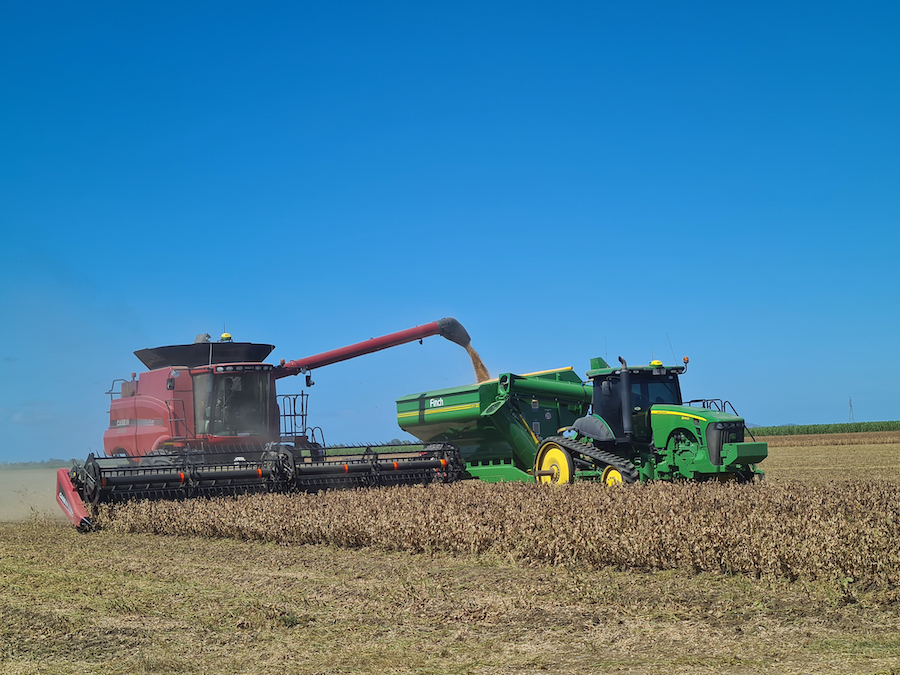Key points:
- Sugarcane growers are increasingly diversifying into other crops, including soybeans
- It has allowed Toowoomba-based PB Agrifoods to source two soybean crops a year from growers
- Crop rotational diversification creates opportunities to explore on-farm storage
- Workshops have been held to better understand storage options
- GRDC-invested research into stored grain, new varieties and agronomics is helping growers adapt traditional rotations
The recent run of dry conditions in traditional inland soybean growing regions, coupled with innovative sugarcane growers keen to try something new, has seen coastal soybean plantings increase in recent years.
The move is helping broaden soybean supply and has come about due to a concerted effort by Toowoomba-based PB Agrifood, complemented by strategic GRDC investments in research, development and extension (RD&E).
Improving cane growers’ understanding of soybean varieties, agronomic management and grain storage options, as well as fostering industry confidence in the new crop, has been the work of some key GRDC-supported researchers. Queensland Department of Agriculture and Fisheries (DAF) coastal farming systems team leader Neil Halpin, along with GRDC grain storage team member and DAF research agronomist Philip Burrill and CSIRO soybean breeder Dr Andrew James, have all worked closely with growers.
Former PB Agrifood field officer Andrew McDonald says that although the company has always sourced small tonnages of soybeans from the north, the group effort has proved valuable in building momentum.
“Sugarcane growers are interested in the extra cashflow, weed control and nitrogen fixation offered. Also, soybeans break the sugarcane monoculture and the cane-specific pathogens that build up in a monoculture,” Mr McDonald says.
“The large planting of soybeans started in 2017 with the availability of the Hayman variety. Hayman was very well suited to the northern climate and suitable for all domestic markets, which we struggled to supply at the time.”
Many growers are now planting two crops a year in between sugarcane, he says, which is also improving cane yields. Being able to source north Queensland soybeans has helped PB Agrifood ensure continuity of supply for its domestic and export markets.

Soybeans being harvested at Kevin Fiamingo’s property in north Queensland. Photo: Kevin Fiamingo
However, many experts including Mr McDonald believe the real opportunities for this crop are likely to come through the development and growth in export markets for the non-genetically-modified soybean human consumption market.
This has been a difficult market for Australian manufacturers to consistently supply due to fluctuating production, he says. Australian processors and marketers needed consistency of supply and were looking to increasingly engage with soybean growers to help take advantage of potential market opportunities.
“My role has been to increase soybean tonnage and we’ve done that by growing two crops a year and getting the agronomic package, varieties and storage right.”
GRDC senior regional manager (north) Gillian Meppem agrees, saying strategic RD&E is playing a vital role building growers’ confidence in trialling new or non-traditional crops.
“GRDC has been supportive of increasing grain production in non-traditional areas by ground-truthing or testing known research at local levels so growers and advisers understand how outcomes can be applied on-farm in different regions,” Ms Meppem says.
“As part of a broader team that includes DAF and private enterprise, this is an exciting opportunity to assist growers to make informed decisions from the beginning of their venture into new cropping rotations.”
Going forward at a practical, paddock level, Mr McDonald hopes to see more herbicide-tolerant varieties to improve weed control options.
This is something that soybean breeder Andrew James is working on. Dr James explains that the first round of tolerant varieties – Kuranda HB1, New Bunya HB1 and Mossman HB1 soybean varieties – have the ALS1 gene. “This confers enhanced tolerance to halosulfuron-methyl. This is a ‘naturally occurring’ gene. So, its use will not disrupt markets for human consumption, which require non-genetically-modified crops.”
The next stage is to increase the tolerance of these varieties to other Group B herbicides. “This will be important as they will incorporate broadleaf legume weed control, one of the biggest issues we face,” Mr McDonald says.
GRDC is looking to work with potential chemical registrants to ensure that suitable Australian Pesticides and Veterinary Medicines Authority (APVMA) approvals are in place so that growers can make use of the weed control benefits that these herbicide tolerant varieties bring.

























































